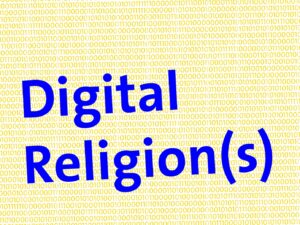On April 1, 2022, researchers and numerous guests met at the Museum für Gestaltung in Zurich for the kick-off event of the University Research Priority Program (URPP) Digital Religion(s).1 The research activities had begun in January 2021, project teams had formed, and first preliminary results were already available. This was the moment to publicly celebrate the launch of the URPP, albeit somewhat delayed. The various contributions to the program impressively demonstrated the diversity and relevance of the topic and the variety of disciplines, approaches, and perspectives involved and empirical contexts studied.

In this blog article, I take this kick-off event as a starting point to explore how something like digital religion(s) might manifest in the activities of contemporary organizations. Addressing this question is in line with attempts to better understand the relationship between religion and organization. Within the research field of digital religion(s), the question might stimulate reflection on the relationship between researchers, their research activities, and the phenomena studied.
Methodologically, I loosely follow the tradition of organizational ethnography. I draw upon observations and experiences made during my participation in the kick-off event and my experience as a researcher at the URPP. On this basis, I present some observations on the role of digitality in the activities of the URPP as an organization. I then connect these to two approaches from institutional theory to reflect on the potential role of religion and its relation to digitality.
The kick-off event in the context of the set of URPP activities
University Research Priority Programs are interdisciplinary organizational units established by the University of Zurich to support “its position among the world’s leading research institutions” by creating and promoting academic networks in selected areas of research and by contributing “to the advancement of knowledge in areas of research that benefit society”. Similar to many other contemporary organizations, the URPP has experienced a recent duality, and sometimes perceived tension, between digital and nondigital forms of communication. This is mainly manifest in two ways of carrying out a core activity, meetings at the level of management, program, modules, and projects: They are carried out either digitally via video conferencing software or on site.
These two modes of meeting are associated with different meanings and purposes. In reality, a number of factors come into play in a decision taken by the organizers about the mode of a meeting. Simply put, it seems that digital meetings tend to be preferred when the meeting is seen primarily as an instrument for achieving certain business objectives, such as dealing with prepared agenda items, evaluating the progress of a project, and discussing next steps. On-site meetings seem to be preferred when it is not only the business aspect that takes priority but also the relationships between the participants. Junior scholars have tried to cultivate this meeting character in online meetings with the use of special software which mimics, for instance, a bar environment. Their results have been mixed at best. In other words, digital meetings are more a means to an end. In on-site meetings, additional importance is placed on the meeting itself.
The kick-off event is a remarkable example of this second case. Participants are physically present at an event room to listen to various accounts about the URPP, to retrospectively celebrate its birth, and to meet, eat, drink, and chat together. The importance of such an event cannot be explained from a purely instrumental perspective. The event has a ceremonial and festive character without any direct practical consequences for the URPP’s work. No research work is carried out during the event, and no project is directly developed further. Although some ideas for future research may arise and some aspects of the research are presented to interested guests, the main purpose of the event is neither idea generation nor science communication. The purpose seems to lie somehow in the event itself. I suggest that it lies in the URPP as a social entity taking form. It is still perceived as an organizational instrument to meet certain goals, but also as something more than that.
Organizational ends in institutional theory
In institutional approaches to organization studies, two perspectives take up this idea of social entities associated with some ends in themselves. One is from Philip Selznick. He describes how organizations that serve as instruments for a certain purpose become institutions through a process of infusion with values. Through value infusion, they become ends in themselves and develop lives of their own.
Roger Friedland has developed the notion of institutional logics at the level of societal institutions such as democracy, family, and private property. He conceives of society as an interinstitutional system constituted by various institutional domains, each with its own logic and each centering around a focal institutional value.
Institutions, according to Friedland, thus function like religions. They are characterized by an institutional god or central institutional value. This value, for example private property or democracy, is transcendent, but it is embodied in material practices, such as buying and selling goods or voting, in accordance with its associated institutional logic. Institutions are characterized by this combination of transcendent and immanent or symbolic and material dimensions. An institutional logic is in this sense “a trinitarian order of production”. Institutional theory can thus be pursued as a kind of comparative sociology of religions. The institutional environment in which organizations are embedded is associated with various institutional gods or values. From this environment, people must choose the god or value that they serve.

Organizational character formation, digitality, and religion
The process by which an organizational entity is infused with value, that is the formation of its organizational character, can take place both on site and digitally. With reference to Selznick, one might say that the kick-off event made visible the formation of the URPP as a social entity, which is more than a means to an end. However, it is not only on-site meetings that can contribute to this formation. According to Selznick, the value-oriented character of an organizational institution takes form especially while the organization deals with the specific problems that it faces, and such problems can occur and be dealt with both on site and in digital settings.
Is this formation of a living social entity something religious? With reference to Friedland, one might tend to say yes, even if he has not organizational but societal institutions in mind. But even if one does not categorize it as such, the process is still remarkable. And it might be a promising exercise, not only for a group of researchers but also for contemporary organizations more broadly, to reflect upon which god they pay homage to through their activities, or precisely what is of central value to them.
Download blog article with references here:
Blog article by Dr. Tobias Brügger, URPP project P4 The Corporate Governance of Religious Organizations in a Digital Society
1 I thank Katja Rost, Jan Danko, and Simon Milligan for helpful comments.



